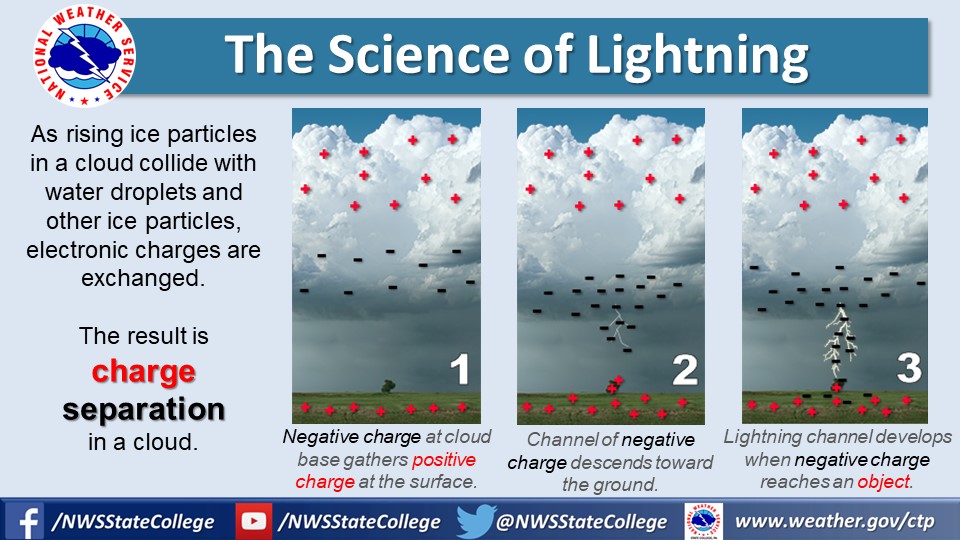Lightning is a fascinating phenomenon that occurs every year across Pennsylvania. Have you ever wondered how lightning forms? Or perhaps how to stay safe if you are outside and hear that low rumble from an approaching thunderstorm? Keep reading to find out!
Snow crystals in a thunderstorm?

Thunderstorms are composed of countless water droplets, ice crystals, and graupel. Graupel is a small, soft ice pellet that forms when water droplets freeze onto a snow crystal in a process called riming.
Rising and sinking air within the storm causes the graupel to crash into water droplets and ice particles. This collision leads to a separation of electrical charge; the graupel takes on a negative electrical charge and the other particles take on a positive charge. Since graupel (negative charge) is heavier than the water and ice crystals, it sinks to the lower part of the storm cloud while the lighter particles (positive charge) collect higher up in the cloud. Eventually, the separation of charge becomes so large that a channel forms between the positive and negative regions.
The resulting electrical transfer within that channel is what we see as lightning!
In addition to lightning being created within the thunderstorm cloud, lighting can be created in a channel between the cloud and ground. Known as cloud-to-ground lightning, the channel forms outside of the cloud due to the charge difference between the base of the cloud and the ground. Most of the lightning, about 75-80 percent, occurs with the storm cloud, with the remaining 20-25 percent occurring between the cloud and the ground.
A Shocking Fact
Lightning is extremely hot; in fact, it can reach temperatures as high as 54,000°F. Lightning rapidly heats the air around it in less than a second, which causes a shock wave of expanding and contracting air that moves at the speed of sound away from the lightning channel.
This shock wave is what we hear as thunder!
We see lightning before we hear thunder due to how fast light and sound waves travel. The flash of light that we see as lightning travels at the speed of light to our eyes (about 186,000 miles per second), while thunder travels at the speed of sound (about 0.21 miles per second). It takes sound waves about five seconds to travel one mile, so if you count the number of seconds between the flash of lightning and the sound of thunder, then divide that number by five, you’ll get how many miles you are away from the lightning!
Remember, if you’re close enough to hear thunder, then you’re close enough to be struck by lightning which is why we always say, “When thunder roars, go indoors!”
Take Charge: Stay Safe
So now that we understand how lightning works, what can we do to stay safe from it?
One of the best ways to stay safe in a lightning storm is to plan ahead. Check the forecast and know when there is a risk for thunderstorms. If you plan to be outdoors, make sure you have a safe place to take shelter if needed. The best shelter locations are either in a building or in a car. If you’re out camping, a tent is not a safe place to be instead, make sure you can go to a sturdy structure or your vehicle as soon as possible.
You should never take cover under a tree or other object that could act as a conductor to lightning. Remember, lightning can strike as far as ten miles away from a thunderstorm, so even if you can only hear thunder or see a distant lightning strike, you could still be in danger and should take cover until the storm has passed. Check out the Ready PA lightning tip sheet (PDF).
Learn More
- For more information on lightning and how it works, be sure to check out www.weather.gov/jetstream/lightning.
- Know the threats! Visit the Ready PA Thunder and Lightning page to learn how to stay safe when “thunder roars”!
- Remember that Lightning Awareness Week runs June 20-26 this year, so keep an eye out for all sorts of interesting information from NWS State College and our partners!
- Also take a look at the Ready PA monthly newsletter for more preparedness tips.